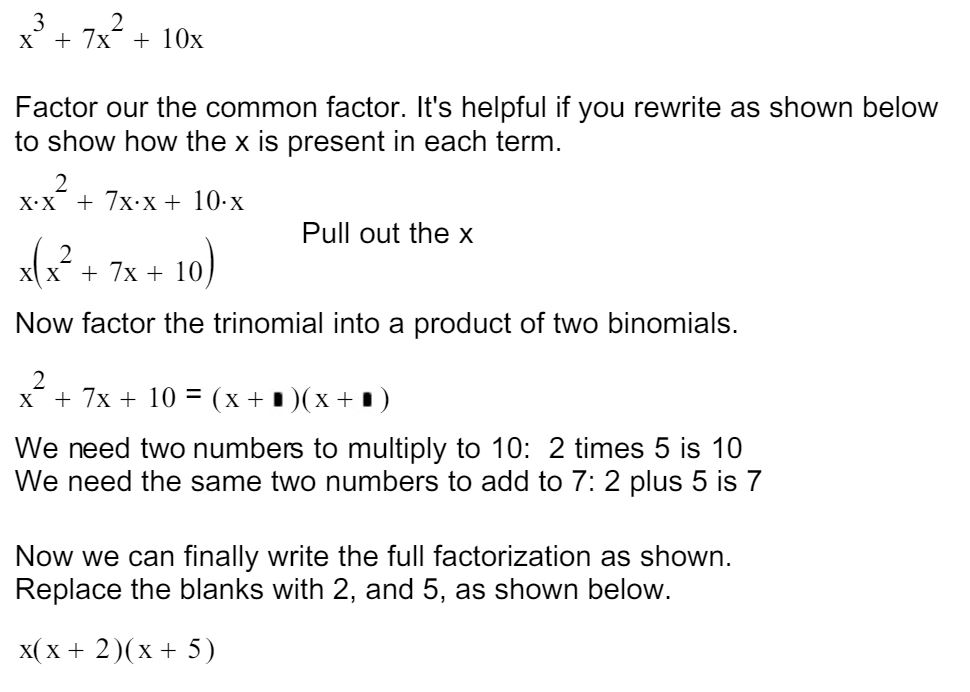Step 1: Look at the expression x³ + 7x² + 10x.
You have three terms: x³, 7x², and 10x.
The first question to ask is: What is common among all these terms?
Answer: Each term has an x:
- x³ has x × x × x
- 7x² has x × x
- 10x has just one x
So we can say that x is a part of every term.
That’s why we take x out of each term and write it as x(x² + 7x + 10).
By doing this, we’re simplifying the expression. We’re breaking it down into parts that are easier to manage. That’s the whole idea behind “factoring.”
Step 2: Now we look at x² + 7x + 10 that’s inside the brackets.
We want to factor this quadratic expression. To do this, we look for two numbers that:
- Add up to the coefficient of x, which is 7, and
- Multiply to the constant term, which is 10.
The numbers that fit these conditions are 5 and 2 because 5 + 2 = 7 and 5 × 2 = 10.
So, we can rewrite x² + 7x + 10 as (x + 5)(x + 2).
Step 3: Putting it all together, we have x(x + 5)(x + 2).
And there you have it! You’ve successfully factored the expression x³ + 7x² + 10x into x(x + 5)(x + 2).

Example: Factoring 2x⁴ + 8x³ + 6x²
Step 1: Examine the expression 2x⁴ + 8x³ + 6x².
First, let’s identify what is common among all the terms.
Every term contains x and an even number as a coefficient:
- 2x⁴ has 2 and x⁴
- 8x³ has 8 and x³
- 6x² has 6 and x²
The greatest common factor for the coefficients (2, 8, 6) is 2, and each term has at least x².
So, we can factor out 2x² from each term, resulting in 2x²(x² + 4x + 3).
Step 2: Focus on the x² + 4x + 3 inside the brackets.
We aim to factor this quadratic expression by looking for two numbers that:
- Add up to the coefficient of x, which is 4.
- Multiply to the constant term 3.
The numbers that meet these conditions are 3 and 1, as 3 + 1 = 4 and 3 × 1 = 3.
So we rewrite x² + 4x + 3 as (x + 3)(x + 1).
Step 3: Combine all the factors.
We now have 2x²(x + 3)(x + 1) as the fully factored expression.
Congratulations! You’ve successfully factored the expression 2x⁴ + 8x³ + 6x² into 2x²(x + 3)(x + 1).
Example: Factoring -3x⁴ – 9x³ + 12x²
Step 1: Examine the expression -3x⁴ – 9x³ + 12x².
First, let’s find what is common among all the terms.
All terms contain x and coefficients that are multiples of 3:
- -3x⁴ has -3 and x⁴
- -9x³ has -9 and x³
- 12x² has 12 and x²
The greatest common factor for the coefficients (-3, -9, 12) is 3, and each term has at least x².
We can factor out -3x² from each term, resulting in -3x²(x² + 3x – 4).
Step 2: Focus on the x² + 3x – 4 inside the brackets.
We aim to factor this quadratic expression by looking for two numbers that:
- Add up to the coefficient of x, which is 3.
- Multiply to the constant term -4.
The numbers meeting these conditions are 4 and -1, as 4 + (-1) = 3 and 4 × (-1) = -4.
So we rewrite x² + 3x – 4 as (x + 4)(x – 1).
Step 3: Combine all the factors.
We now have -3x²(x + 4)(x – 1) as the fully factored expression.
Congratulations! You’ve successfully factored the expression -3x⁴ – 9x³ + 12x² into -3x²(x + 4)(x – 1).